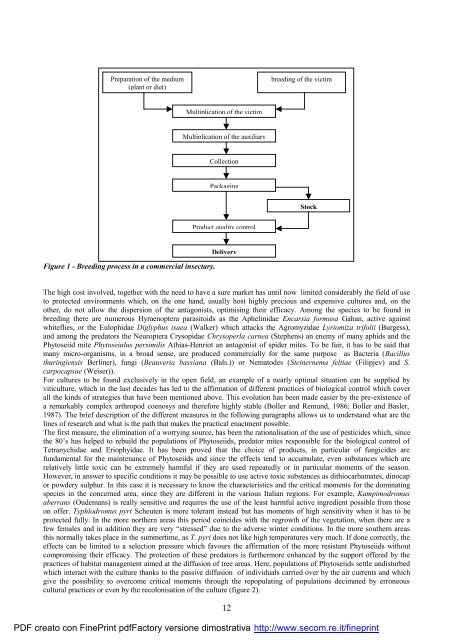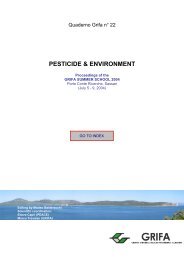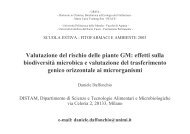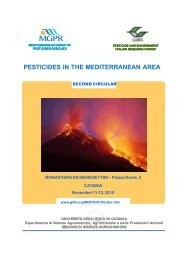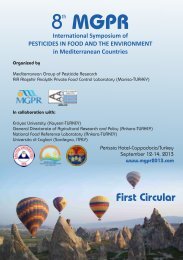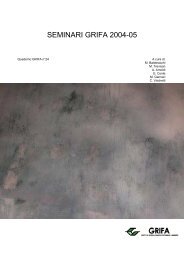International Congress BIOLOGICAL PRODUCTS - Gruppo di ...
International Congress BIOLOGICAL PRODUCTS - Gruppo di ...
International Congress BIOLOGICAL PRODUCTS - Gruppo di ...
You also want an ePaper? Increase the reach of your titles
YUMPU automatically turns print PDFs into web optimized ePapers that Google loves.
Preparation of the me<strong>di</strong>um<br />
(plant or <strong>di</strong>et)<br />
Figure 1 - Bree<strong>di</strong>ng process in a commercial insectary.<br />
Multiplication of the victim<br />
Multiplication of the auxiliary<br />
Collection<br />
Packaging<br />
Product quality control<br />
Delivery<br />
The high cost involved, together with the need to have a sure market has until now limited considerably the field of use<br />
to protected environments which, on the one hand, usually host highly precious and expensive cultures and, on the<br />
other, do not allow the <strong>di</strong>spersion of the antagonists, optimising their efficacy. Among the species to be found in<br />
bree<strong>di</strong>ng there are numerous Hymenoptera parasitoids as the Aphelinidae Encarsia formosa Gahan, active against<br />
whiteflies, or the Eulophidae Diglyphus isaea (Walker) which attacks the Agromyzidae Lyriomiza trifolii (Burgess),<br />
and among the predators the Neuroptera Crysopidae Chrysoperla carnea (Stephens) an enemy of many aphids and the<br />
Phytoseiid mite Phytoseiulus persimilis Athias-Henriot an antagonist of spider mites. To be fair, it has to be said that<br />
many micro-organisms, in a broad sense, are produced commercially for the same purpose as Bacteria (Bacillus<br />
thuringiensis Berliner), fungi (Beauveria bassiana (Bals.)) or Nematodes (Steinernema feltiae (Filipjev) and S.<br />
carpocapsae (Weiser)).<br />
For cultures to be found exclusively in the open field, an example of a nearly optimal situation can be supplied by<br />
viticulture, which in the last decades has led to the affirmation of <strong>di</strong>fferent practices of biological control which cover<br />
all the kinds of strategies that have been mentioned above. This evolution has been made easier by the pre-existence of<br />
a remarkably complex arthropod coenosys and therefore highly stable (Boller and Remund, 1986; Boller and Basler,<br />
1987). The brief description of the <strong>di</strong>fferent measures in the following paragraphs allows us to understand what are the<br />
lines of research and what is the path that makes the practical enactment possible.<br />
The first measure, the elimination of a worrying source, has been the rationalisation of the use of pesticides which, since<br />
the 80’s has helped to rebuild the populations of Phytoseiids, predator mites responsible for the biological control of<br />
Tetranychidae and Eriophyidae. It has been proved that the choice of products, in particular of fungicides are<br />
fundamental for the maintenance of Phytoseiids and since the effects tend to accumulate, even substances which are<br />
relatively little toxic can be extremely harmful if they are used repeatedly or in particular moments of the season.<br />
However, in answer to specific con<strong>di</strong>tions it may be possible to use active toxic substances as <strong>di</strong>thiocarbamates, <strong>di</strong>nocap<br />
or powdery sulphur. In this case it is necessary to know the characteristics and the critical moments for the dominating<br />
species in the concerned area, since they are <strong>di</strong>fferent in the various Italian regions. For example, Kampimodromus<br />
aberrans (Oudemans) is really sensitive and requires the use of the least harmful active ingre<strong>di</strong>ent possible from those<br />
on offer. Typhlodromus pyri Scheuten is more tolerant instead but has moments of high sensitivity when it has to be<br />
protected fully. In the more northern areas this period coincides with the regrowth of the vegetation, when there are a<br />
few females and in ad<strong>di</strong>tion they are very “stressed” due to the adverse winter con<strong>di</strong>tions. In the more southern areas<br />
this normally takes place in the summertime, as T. pyri does not like high temperatures very much. If done correctly, the<br />
effects can be limited to a selection pressure which favours the affirmation of the more resistant Phytoseiids without<br />
compromising their efficacy. The protection of these predators is furthermore enhanced by the support offered by the<br />
practices of habitat management aimed at the <strong>di</strong>ffusion of tree areas. Here, populations of Phytoseiids settle un<strong>di</strong>sturbed<br />
which interact with the culture thanks to the passive <strong>di</strong>ffusion of in<strong>di</strong>viduals carried over by the air currents and which<br />
give the possibility to overcome critical moments through the repopulating of populations decimated by erroneous<br />
cultural practices or even by the recolonisation of the culture (figure 2).<br />
12<br />
bree<strong>di</strong>ng of the victim<br />
PDF creato con FinePrint pdfFactory versione <strong>di</strong>mostrativa http://www.secom.re.it/fineprint<br />
Stock


